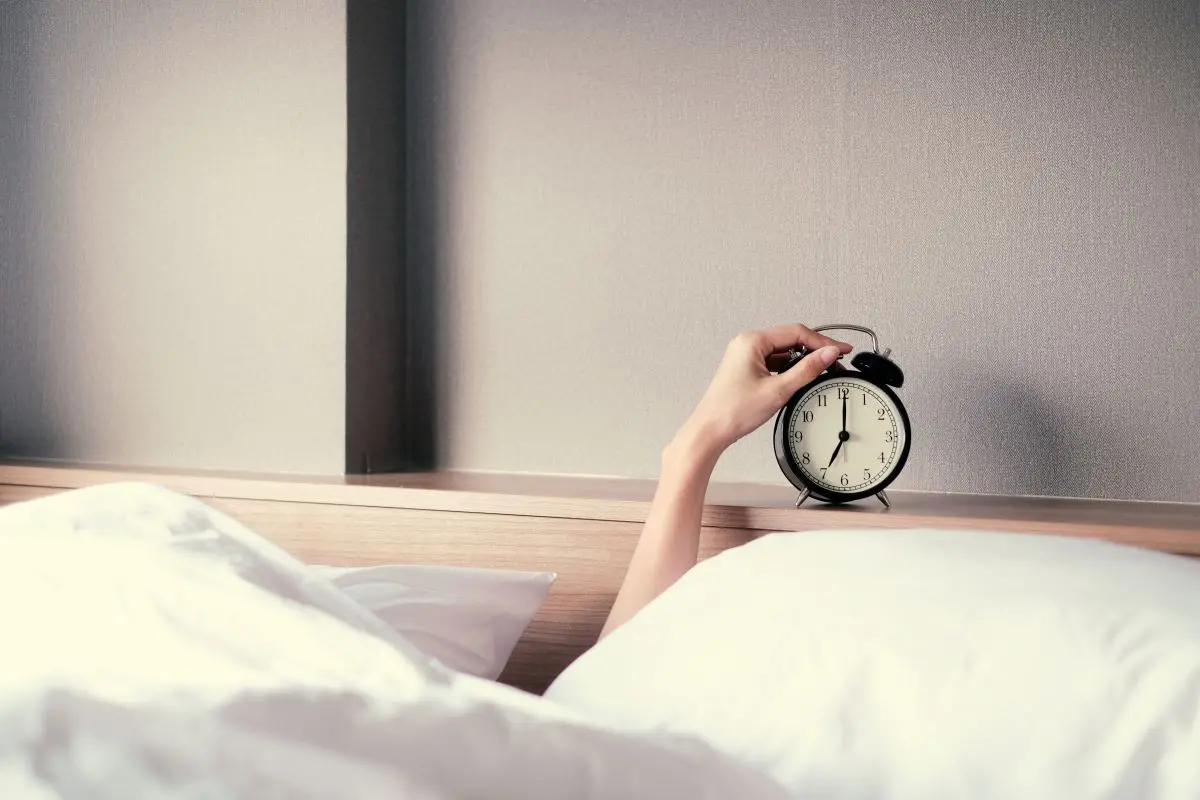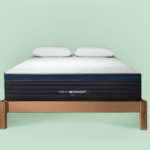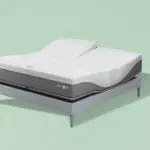Table of Contents
- Using products like adjustable beds may help improve some health concerns that affect your sleep, including snoring, acid reflux, and chronic pain. Regardless of medical status, the ability to change position can provide a better night’s sleep for anyone.
- Based on survey results and in-person testing, the most important adjustable bed features include easy adjustments, preset positions, and adjustable leg height. Warranty length, trial period, and white glove delivery also set brands apart.
- After testing 14 adjustable beds, Nectar is the Handbook Team’s top pick due to its luxury features like massage and built-in USB ports, 50-night trial, and extended warranty, which covers the adjustable base for up to 10 years, something no other brand offers.
Sleep disturbance is a serious issue that impacts mental health. According to the Centers for Disease Control and Prevention, about 35 percent of adults regularly sleep less than the recommended seven hours per night, and people who don’t sleep enough are 2.5 times more likely to feel stressed, anxious, or depressed.
If you’re one of the many people who need to improve your sleep, talk to your doctor about your options. The Handbook Team understands how nerve-wracking it can be to make a change, but we’re here to empower you to take control of your health.
Some medical conditions affecting sleep, like snoring, acid reflux, or chronic pain, can be improved by changing your sleeping position with products like adjustable beds. For example, elevating the head can help relieve neck and back pain, while raising the legs may reduce lower back pain and improve circulation.
Additionally, adjustable bases can reduce pressure points, decrease muscle tension, and promote spinal alignment, which may help relieve pain.
Adjustable beds also come with helpful features designed to enhance comfort and convenience. Many models include USB ports, allowing you to charge your devices while you rest. Remote controls enable you to adjust the bed’s position easily, and some adjustable beds feature massage functions for targeted relief and relaxation.
The ability to change position can provide a better night’s sleep for anyone. When we surveyed 600 adjustable bed owners, more than 500 said their sleep improved after sleeping on an adjustable bed. This was a significant finding, so the Handbook Team investigated.
We test the best adjustable beds and work with sleep experts to find the top brands on the market, uncovering why they’re helpful and who they can benefit. Learn why Nectar is our top pick and the most important features to consider so you can feel confident choosing the right adjustable bed for your needs.
Which adjustable bed is right for you?
- Nectar: Best overall
- Saatva: Best features
- DreamCloud: Most customizable
- Helix: Best value
- Brooklyn Bedding: Easiest assembly
- Tempur-Pedic: Best for advanced tech
- Sleep Number: Best mattress and adjustable base combination
Why HelpGuide cares about a good night’s sleep




Quality sleep is a key part of mental health, physical health, and overall well-being. Sleep helps us reset our bodies, process our emotions, and squash daily stressors. Without it, we can develop chronic mental health issues like anxiety and depression, according to research.
But there are medical conditions that can make sleep difficult. Chronic pain, acid reflux, loud snoring or sleep apnea, and insomnia are issues that can keep you up at night.
Finding solutions for better sleep can be frustrating, but we’re here to help. The HelpGuide Handbook Team wants to empower you to make the right decision by providing the most honest information about sleep health and related products, like adjustable beds.
Good sleep is essential for physical and mental health because it’s our body’s chance to recharge after the physical and cognitive loads of our day. When we sleep well, we have better relationships and communication with our partners, we can think more clearly, and we’re in a better mood.
Julia Catlin, licensed psychotherapist at Calm Science in Las Vegas.
In order to recommend the best options to fit someone’s needs, we sought to better understand how sleep impacts overall health. We consulted with mental health experts, researchers, and industry leaders in sleep and ergonomics to connect the dots about what really matters in an adjustable bed experience.
Ultimately, we want to support your sleep health and overall mental well-being. Through in-depth testing and research, we aim to take the stress out of your search for better sleep by sharing our findings with you here.
Learn more about our adjustable bed review methodology.
What you need to know about adjustable bed research and testing
Here are the five most important things to know about adjustable beds.
Our testing experience
The Handbook Team mystery shopped in showrooms and third-party retailers, testing each adjustable bed’s features and interacting with in-store clerks. We evaluated brands and models by recording our findings on a 36-question standardized testing form to identify standout features and services, document problems with each product, and describe what our shopping experience was like. For example, we recorded:
- Adjustment speed, noise, and feel.
- Massage modes, intensities, and quality.
- Customer service experience and general satisfaction.
We searched for adjustable beds that offered the best fundamentals, like easy adjustability and a user-friendly control system, so all of our options fit the basic needs identified by respondents of a survey of 600 adjustable bed owners. We also interviewed real people who bought adjustable beds, digging deeper into the reasons why an adjustable bed worked for them—or why it didn’t.
According to our survey, about 91 percent of respondents reported they sleep better with their adjustable base, and 73 percent noticed improved mental health. All focus group participants agreed their adjustable beds improved their sleep, and their only regret was not buying one sooner.
We also considered the functionality and practicality of advanced features, like massage, lighting, and mobile applications, which can offer convenient ways to relax and unwind. We found the effectiveness of advanced features was based on personal preference. For example, several testers didn’t like the massage quality in some adjustable beds, noting how it felt like intense vibration rather than kneading. But you might find the vibrations relaxing, depending on your tolerance.
In order to focus on the adjustable bases themselves, we structured our test designs so they isolated the bases and judged them on criteria independent of the mattress. For example, we tested the capabilities of the adjustable bases, such as positioning options, that are the same no matter what mattress you use. It is important to note that certain criteria like mattress firmness will have an impact on your comfort, but we strategically organized our test designs to focus on the comfort of the adjustable base regardless of what mattress you have. Read our review of the best mattresses for adjustable beds to learn more.
Lastly, we compared warranty lengths, trial periods, and white glove delivery (in-home delivery and setup) options. While most brands offer warranties, not all are comprehensive. And many brands on the market don’t have trial periods or free white glove delivery. This could be a deal-breaker if you’re nervous to invest in a healthier sleeping environment because you’re worried the bed won’t get set up properly or offer what you need.
From one of our testers
“During our testing, we realized that many beds are manufactured by the same company: Leggett and Platt. This means a lot of beds are very similar. But it’s the brand’s warranty, trial period, and white glove delivery option that really shows how devoted it is to the customer.”
Read more about our adjustable bed testing methodology.
Compare the best adjustable beds
| Price range | $1,399–$3,596 | $1,249–$2,598 | $1,798-$3,596 | $999-$1,999 | $699-$1598 | $899–$4,798 | $1,299–$13,499*** |
| Best for | Overall pick | Features | Customizable options | Value seekers | Easy assembly | Advanced tech | Mattress and base combo |
| Warranty (years) | 3 | 15–25 | Three-year limited | 10-year limited | 10 years | 25 | 25 |
| Trial period? (nights) | 50 | No | 50 nights | No | No | No | No |
| White glove delivery? | Yes, $199** | Yes, free | No | No | No | Yes, free | Yes, free |
*Some sizes not available in certain models
**The white glove delivery offer frequently changes, so check with customer service to make sure it’s available for your order
***The Sleep Number Climate 360 Smart bed in a Flex Top California King includes both the mattress and adjustable base.
The best adjustable bed reviews
1. Nectar: Best overall
2. Saatva: Best features
3. DreamCloud: Most customizable
4. Helix: Best value
5. Brooklyn Bedding: Easiest assembly
6. Tempur-Pedic: Best for advanced tech
7. Sleep Number: Best mattress and adjustable base combination
What is an adjustable bed?
An adjustable bed is a type of bed frame that allows you to customize your sleeping position by adjusting the head and foot sections. This feature helps promote spinal alignment by allowing you to find the most comfortable and supportive position for your body.
Whether you need to elevate your head to reduce snoring or lift your legs to improve circulation, an adjustable bed makes it possible.
In addition to enhancing comfort, adjustable beds cater to various health needs. Customizing the adjustable position to find the perfect angle to support your spine may help alleviate conditions like sleep apnea, acid reflux, and back pain.
With a simple remote control or a mobile app, you can adjust the bed to your preferred position, making it easier to read, watch TV, or simply relax in bed.
Pros and cons of adjustable beds
What we like about adjustable beds
- Convenient sleep positioning: Adjustable beds come with basic head and foot adjustability, which can help alleviate common medical issues, like snoring and acid reflux. Pillows and wedges yield similar results, but adjustable beds are more convenient for people who like to reposition themselves or try different angles for relief rather than fussing around with props that move in the night. Brands have evolved to include more adjustable features, like lumbar support, to better fine-tune your sleeping position and offload pressure where you need it most.
- Customers stand behind the product: All focus group participants agreed that they sleep better with their adjustable bed and wish they had committed to it sooner to alleviate chronic pain, improve acid reflux severity, address their partner’s snoring, or simply sleep better. About 91 percent of our 600 survey respondents said they also sleep better with their adjustable base, and 73 percent said they noticed improved mental health.
- Customization: Split king adjustable beds allow partners to independently choose their preferred sleeping positions using a remote, providing personalized comfort for each person. This feature ensures both individuals can adjust their side of the bed to their liking without disturbing the other. This can provide better sleep quality for both. Check out our best split king adjustable bed review for more benefits.
What we don’t like about adjustable beds
- They can be expensive: Most adjustable beds start around $1,000 before promotions and discounts. They shouldn’t be everyone’s first option, so try propping yourself with pillows and wedges before investing in an adjustable bed. If it works for you but you need more convenient adjustability, look for deals to avoid buying a bed at full price. Don’t forget to look into financing, as every brand in our list offers financing options through third-party lenders at checkout.
- Most sales are final: Unfortunately, most brands avoid trial periods due to bulky product shipping. We chose to include as many brands with trial periods as possible because we know how scary it can feel to change your sleeping accommodations, fearing it may worsen matters. You deserve to feel confident in an investment that prioritizes your health, so if you’re nervous about changing your bed, go with a brand that has a trial period, like Nectar or DreamCloud.
How much does an adjustable bed cost?
Handbook Team Tip #1
Look out for discount codes. Brands like Nectar and Saatva have discounts for certain types of professionals or age groups, including military members and students.
Adjustable beds cost between $300–$7,000 depending on the brand, size, and features.
This review lists brands with adjustable bed options starting at $699 before deals and promotions, keeping prices closer to most people’s budget of $2,000 or less. Remember that some brands, like Nectar, reduce costs by up to 50 percent during certain offers.
Are adjustable beds covered by Medicare or Medicaid?
Because adjustable beds are DME, or Durable Medical Equipment, they are covered under Medicare Part B. In order to take advantage of this benefit, you must secure a prescription from a doctor stating that the bed is a medical necessity because of a health condition, such as an extensive injury, a cardiac condition, or chronic obstructive pulmonary disease. You will be expected to secure the bed using one of Medicare’s approved medical equipment suppliers and you may have some out-of-pocket costs, like a copay, associated with the purchase. Medicaid may or may not cover an adjustable bed as part of their coverage of durable medical equipment. Since Medicaid benefits vary from state to state, check with your individual provider to learn more about adjustable bed coverage.
Key features to look for in the best adjustable beds
Below are the most important features of an adjustable bed, as identified by our focus group participants, survey results, and testers.
Smooth, intuitive head and foot adjustments
Although some beds (like the Sleep Number FlexFit 1) only elevate the head, most adjustable beds offer both head and foot adjustments.
We found that the best adjustable beds have:
- Easy-to-use remote control designs with intuitive icons.
- Smooth adjustment mechanisms with a one- to two-second response lag to avoid jerking motions that shake the bed.
- Quiet motors with no more than 30 decibels or a whispering sound level.
- Adjustment times to a fully upright position of 20–30 seconds.
Preset positions
Presets are factory-set buttons that adjust your bed with one press rather than holding down the elevate or lower buttons. They’re a major convenience for people with dexterity issues, like arthritis of the hand and fingers, who might have difficulty manipulating the small remote buttons. They’re a minor convenience for those of us who just want to get into certain positions faster.
The most common preset positions are:
- Flat: Returns you to a flat sleeping position.
- Zero gravity: Elevates the head and the legs so the legs are above the heart, placing your body in a cradled position that some may find relaxing and relieving.
Anti-snore: Elevates the head several degrees (the exact amount depends on the brand) to alleviate snoring by opening the airway and offloading gravity’s pressure on the chest. Pressure on the chest can make it difficult for some people to breathe, such as those with sleep apnea or chronic obstructive pulmonary disease (COPD). - Reading or TV: Raises the head of the bed to a fully upright position, which is often 60 degrees or higher. This position is best for sitting and reading in bed.

Custom presets
Custom or memory presets are unprogrammed buttons that you can set to your favorite positions. You can change these buttons at any time, usually by adjusting the bed to your desired position and holding the button down until you hear a sound from the remote or see a light. Some beds have special instructions, so read the user manual if you need help.
The best adjustable beds have at least one custom preset, but we’ve seen up to three in Purple Premium adjustable beds.
Varying leg heights
Most beds have different leg heights for your adjustable bed, but they’re not something you can adjust from your remote. You’ll have to set your leg height during setup. This is a crucial feature for most people because you can:
- Remove the legs entirely and place the adjustable base on an existing foundation or bed frame.
- Set the base close to the ground to prevent the sleeper from falling from the bed and causing injury.
- Set the base up high for under-bed storage.
- Customize the bed’s leg height to your height for easier access, which is ideal for people with mobility issues who have trouble getting in and out of bed.
When we tested adjustable beds in big-box retailers, we saw a variety of mattresses paired with adjustable bases, ranging from thick innersprings to thin memory foam options. It was obvious that thicker, firmer mattresses didn’t conform well to the adjustable bed’s movements. For this reason, we don’t recommend innerspring mattresses with adjustable beds. Instead, opt for hybrid, latex, or memory foam mattresses.
Secondary features to consider
Lumbar support
According to our surveys and interviews, most people like the lumbar support found in Tempur-Pedic adjustable beds and Sleep Number mattress-base combinations despite the price hike. Almost half of all survey respondents who listed lumbar support as their priority had chronic joint or back pain.
Our testers don’t consider this necessary in adjustable bases, as much of this support comes from your mattress choice. But we understand it’s important if you need lower-back support to maintain better spinal alignment throughout the night or provide relief.
Sleeping with good spinal alignment can benefit everyone, as it helps distribute the weight of our body evenly and reduces pressure on certain areas. However, some people may have underlying health conditions affecting their spinal alignment, so it is essential to consult a health care professional for personalized recommendations.
Peter Hinz, doctor of chiropractic at Cool Springs Chiropractic in Franklin, Tennessee
Massage
Although we found this feature is up to personal preference, our survey respondents and some focus group participants enjoy the massage features in adjustable beds. One participant said she often uses the massage setting to help her fall asleep if she’s having difficulty relaxing, but all three of our team’s testers commented that the vibrations felt more annoying than stimulating.
We recommend trying the massage feature in person before spending extra for it.
Wall alignment
When you elevate the head of an adjustable bed, it moves your upper body away from your nightstand. Some advanced adjustable bed models shift the head of the bed towards the wall as it elevates, keeping you near the wall and bedside furniture.
While we felt closer to the nightstand when we tried this feature on the Saatva Adjustable Bed Plus, we still had to reach behind us to grab our phones or use the bedside lamp. It’s a nice feature to have, but it’s not groundbreaking.
Under-bed lighting
The Handbook Team likes the idea of under-bed lighting for better visibility at night, especially for people at risk of falls who could benefit from illuminating obstacles in the dark.
You control this feature by using a button on the remote, but some use movement detection that automatically turns on when you get out of bed, like Sleep Number’s FlexFit bases. One of our focus group members owns a Sleep Number adjustable bed and said her under-bed light was “bright enough to make sure I don’t step on the dog, but not bright enough to startle me.”
Remember, the lighting is dim and easily hidden by a thick bed frame, so if you plan on using your under-bed lighting for safe bedroom navigation, opt for a thin bed frame or skip it altogether. Our testers also noticed the bed illuminates its immediate surroundings well, but because it’s so dim, the rest of the room may remain dark. If you need more lighting, invest in some motion-sensitive night lights along your bedroom walkway.
USB ports
Many advanced adjustable bed models have one or two USB ports on each side of the bed, either along the outside of the base or under the platform. We like that adjustable beds have this feature for convenience, allowing you to charge your phone or tablet and freeing up outlet space for bedside items like a lamp. But it’s unnecessary, and the port placements can be hard to access, especially if you use a surrounding bed frame that blocks them.

Sleep tracking
Some advanced adjustable beds come with sleep sensors and heart rate monitoring, allowing you to track and analyze your sleep quality. These features provide valuable insights into your sleep patterns, helping you make adjustments to improve rest and overall health.
These beds offer a comprehensive view of your nightly sleep by monitoring metrics such as heart rate and movement.
Brand-specific services to consider
The Handbook Team found many adjustable bed models have similar features because the same manufacturer builds them. For example, Leggett and Platt, one of the most common manufacturers, makes Saatva and Tempur-Pedic models.
A good way to differentiate your good options from the best is by comparing warranties, trial periods, and white glove delivery options.
Warranty
Adjustable bed brands offer a wide range of warranties between three years and a lifetime, but most are limited, only covering manufacturer defects fully for a few years with partial coverage after that period. Finding long-term warranty coverage on metal frames and electrical parts is rare. Nectar is the only brand that offers any accidental coverage, even though it’s for a relatively short 10-year period when you opt-in.
Trial period
Trial periods are another brand-specific perk that differentiates good brands from the best. While the industry standard is not to offer a trial, some do, ranging between 30 and 120 nights. Focus group participants stated that budget and fear of commitment were the two biggest reasons they waited to buy, so if you can relate, go with Nectar or DreamCloud.

Handbook Team Tip #3
Some big box retailers replace the brand’s warranty and trial period with their own. Before purchasing a bed from a retailer like Mattress Firm, compare these terms with the brand’s website. You’ll see that Tempur-Pedic adjustable beds have a reduced five- to 10-year limited warranty when bought at Mattress Firm, while Tempur-Pedic showroom and online purchases come with a 25-year limited warranty.
White glove delivery
White glove delivery (known as in-home setup) is also hit or miss, but most brands offer it as an extra service with an additional fee. The only brands in our list that include in-home setup free with your purchase are Saatva and Tempur-Pedic. Otherwise, you’re paying up to $249, but our team recommends working it into your budget if you (and your partner) don’t feel confident lifting heavy boxes or you live in a multistory house or apartment building. Adjustable bases can weigh as much as 200 pounds depending on the brand, and they don’t always fit in elevators. If you don’t have help, hauling the shipment to your bedroom could be nearly impossible.
When you purchase white glove delivery, you may also ask brand delivery partners to remove old mattresses and foundations at checkout. Sometimes this is complimentary when you purchase an in-home setup, and other times it costs extra. For example, Avocado charges $249 for in-home setup, but they charge an extra $30 for old mattress removal. To our knowledge, no delivery partner offers old bed frame removal, which will be your responsibility.
Our final verdict
Nectar has the best overall features, trial period, and reputation on our list, offering advanced functionality and an option to extend your warranty to cover accidental damage. Close behind is Saatva, which showcases a similar set of features but also offers free white-glove delivery, though it doesn’t have the same trial period or warranty options.
Because the Handbook Team acknowledges how difficult it is to commit to a new bed, we prioritized listing budget-friendly brands with a trial period. Nectar and DreamCloud are the best options for people who are nervous about making the switch and need time to determine if the new adjustable bed is right for them. Although Serta didn’t make our list this time, it offers the longest trial period on the market at 120 nights.
Helix and Brooklyn Bedding offer budget-friendly adjustable base options, yet lack the trial period of Nectar and DreamCloud. Tempur-Pedic and Sleep Number sit at higher price ranges in this review, but they both have something unique to offer. Tempur-Pedic offers advanced features that aim to improve your sleep quality over time, like sleep tracking. Sleep Number is the best mattress and adjustable base combination on the market for solo sleepers and couples who want full control over their sleeping environment. That’s because you can adjust your sleeping surface to accommodate your needs on any given day, and you can choose a comfortable mattress.
Most importantly, if you’re struggling to sleep well, don’t wait to address it. Talk to your doctor and see if different sleeping arrangements will complement your treatment plan. Although adjustable beds aren’t for everyone, they may be a great investment if you have sleep apnea, insomnia, acid reflux, chronic pain, or any other medical condition that impacts how well you sleep.
Frequently asked questions
Adjustable beds cost between $300–$7,000 depending on the brand, size, and features.
No. During our testing, it was obvious that thicker, firmer mattresses didn’t conform well to the adjustable bed’s movements. Innerspring mattresses are not recommended with adjustable beds as the springs may deform. Instead, opt for hybrid, latex, or memory foam mattresses.
Yes, but it depends on the person. Some people use head elevation to alleviate snoring and acid reflux, which helps them fall asleep and stay asleep longer. Others may use the leg elevation to offload pressure from their lower back or improve leg swelling.
Every adjustable bed has its own assembly instructions, and some are more complicated than others. The owner’s manual should have instructions to assemble the bed’s parts. If you don’t want to assemble your own bed, opt for a brand that offers white glove delivery or hire a local handyperson to do it for you.
According to our survey and focus group, most people agree that their adjustable bed helps them sleep better and subsequently improves their mental health. Adjustable bed frames offer a customized sleeping experience, allowing you to find the ideal position for support and comfort. With head and foot adjustability and features like lumbar support, you can adjust your bed to help with pain management and individual preferences. Some adjustable bases have anti-snore settings to help individuals and couples improve sleep quality. For those looking to optimize sleep quality, an adjustable bed frame can be an investment worth considering.
While adjustable beds have many advantages, there are some drawbacks to consider. This includes higher costs and potential maintenance expenses related to mechanical components. Electrical components pose a risk of malfunctions, and the aesthetics of a mechanical bed may not suit everyone’s preferences. There are limitations on the type of mattress you can buy, since the mattress needs to be flexible enough to move with the bed base, and some users may find the adjustable features uncomfortable, especially if the bed is shared.
In our review, Nectar Adjustable Bed Frame is the best adjustable bed on the market. But what’s best for you is subjective to your budget and personal preferences.
- Albarqouni, L., Moynihan, R., Clark, J., Scott, A. M., Duggan, A., & Mar, C. D. (2021). Head of bed elevation to relieve gastroesophageal reflux symptoms: A systematic review. BMC Family Practice, 22. Link
- Goldman, S. M. (2005). Nocturnal neuropathic pain in diabetic patients may be caused by spinal stenosis. Diabetic Medicine, 22(12), 1763-1765. Link
- Ioachimescu, O. C., & McNicholas, W. T. (2022). Chronic Obstructive Pulmonary Disease–Obstructive Sleep Apnea Overlap: More Than a Casual Acquaintance. American Journal of Respiratory and Critical Care Medicine, 206(2), 139-141.
- Rovira, J., & Domingo, J. L. (2019). Human health risks due to exposure to inorganic and organic chemicals from textiles: A review. Environmental Research, 168, 62-69. Link
- Scott, A.J., Webb, T.L., Martyn-St James, M., Rowse, G., & Weich, S. (2021). Improving sleep quality leads to better mental health: A meta-analysis of randomised controlled trials. Sleep Medicine Reviews, 60, 101556. Link
- Silvani, M. I., Werder, R., & Perret, C. (2022). The influence of blue light on sleep, performance and wellbeing in young adults: A systematic review. Frontiers in Physiology, 13. Link
- Centers for Medicaid and Medicare Services Medical Coverage Database. National Coverage Determination – hospital beds (280.7).


































